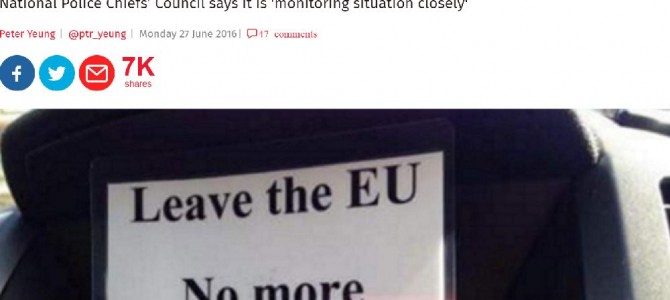
Yellow journalism (noun): journalism based upon sensationalism and crude exaggeration. Example: Monday’s Independent led with the headline: “EU Referendum: Reports of hate crime increase 57% following Brexit vote.”
(NB: This is not a commentary on whether hate crimes are bad. Of course they are. However, for the extremely thick, I feel compelled to mention this obvious fact.)
For the casual observer or citizen who is already prone to believe Britain is an inherently racist nation—or for anyone, for that matter, who doesn’t go on to read the full article, subliminally the message from the headline might easily be misconstrued as “57 percent of Britain is racist.” (I remind those who smirk at the idea of subliminal influence of the outrage over the “Beach Body” advertisement on the Underground.) One thing clearly implied in this headline, however, given that the figure is conveniently sandwiched between the words “EU Referendum” at the beginning and “following Brexit vote” at the end, is that the Leave result is responsible for hate crimes.
With sensational words such as “hate,” “crime,” “Brexit,” “referendum,” and “57%,” the headline also accurately and safely qualifies that the figure indicates reports of hate crimes and not actual confirmation of hate crimes, yet still fails to nullify the fear-based rhetorical impact of this. The word “reports” is a necessary qualifier which also absolves The Independent of printing an outright lie whilst allowing them to rush out a fear-based story that adds to the narrative many readers desperately want to believe.
Lies and Damned Statistics
We now move on to the article itself and the actual figures—again, not of confirmed hate crimes, but of reports of hate crimes: “There were 85 reports of hate crimes according to True Vision, a police-funded reporting website, between Thursday and Sunday compared with 54 reports over the same period four weeks ago.”
So what do we know? We know that, following one of the most historical and contentious referendums in British history, there were an additional 31 reports—again, not confirmations—of hate crimes in Britain. What we do not know, based on the article, is the following:
a) How many of those reports are confirmed and
b) If confirmed, how many of those crimes are racially or otherwise hate-motivated, as well as
c) If confirmed, how many of those crimes were the result of the Brexit vote.
Herein lies the sensationalist potential of statistics. Let’s say we have a community wherein there was one report of a hate crime before the referendum. Following the referendum, that same community reports no more than one additional hate crime. At this point, it would not be factually amiss for The Independent to report “Following EU Referendum, community sees 100% increase in reports of hate crime.” An accurate headline, to be sure, albeit one that makes gross use of misleading sophistry.
But let’s go further into numbers here to widen our perspective on this issue. The total number of votes cast for Leave was 17,410,742. Assuming a) that the reports of hate crimes are confirmed, b) there was only a single perpetrator in each crime, and c) the perpetrators were neither Remainers nor undecideds nor non-voters, the number of Leave voters who were not involved in a hate crime report before the referendum stands at 17,410,688.
Following the referendum, according to The Independent’s measures, that number now stands at 17,410,657. That’s a 1.78 percent increase (and converse decrease) in the number of Leave voters (again, assuming confirmation of the reports, number of perpetrators, and whether the Leave result was a factor) involved in a hate crime report.
But let’s widen our net a little here, seeing as how one of the primary assumptions necessary to the argument thus far has been the responsibility of Leave for these reports of hate crimes.
The current population of Great Britain is 65,111,143. Again, assuming a) confirmation of the reports and b) single perpetrators in each instance, as well as the addition of a new variable c) such that Remainers, undecideds, or non-voters could also be perpetrators, this would mean 65,111,089 citizens were not reported as perpetrators of a hate crime. Following the referendum, (again assuming a, b, and c) that number fell to 65,111,058. Therefore, there was a 4.76 percent increase (and converse decrease) among the entirety of the British populace who were or were not reported as being the perpetrator of a hate crime.
Thanks for Telling Me Hurting People Is Bad
So is there any more meat to this article than what we’ve been fed so far? (I hope so, it’s almost lunchtime!) Well, let’s look at what Assistant Chief Constable Mark Hamilton says about these statistics: “Police forces are working closely with their communities to maintain unity and tolerance and prevent any hate crime or abuse following the EU referendum. At the national level, the vast majority of people are continuing to go about their lives in safety and security and there have been no major spikes in tension reported.”
He adds what the opening paragraph of the article has already told us about the additional 31 reports of hate crimes, but acknowledges the similarity to trends following other major national events in which “crime levels returned to normal relatively quickly.” Helpfully, presuming we weren’t aware by now, Hamilton does add that “all forms of hate crime are unacceptable” and hate crime “damages communities and undermines the diversity and tolerance we should instead be celebrating.”
So what have we learned from Assistant Chief Constable Mark Hamilton, according to The Independent? We’ve learned that diversity and tolerance should be celebrated and that hate crime is a bad thing. What we’ve not learned is, again, a) how many of the reports are confirmed, b) if confirmed, how many are racially or otherwise hate-motivated, and c) if confirmed, whether or not the Leave result is to blame.
Pretty thin gruel there. Still hungry? Let’s read on.
The chief executive for Stop Hate UK, Rose Simkins, tells The Independent the issue “may well get worse.” We don’t know why Simkins is qualified to predict the future, as her credentials to be a modern-day Nostradamus are not put on display in this short article. Perhaps she’s speaking about things getting worse for her. That is to say, if things get better and hate decreases, Rose Simkins of Stop Hate UK may in fact become redundant.
A Wave of Mean Facebook Posts
Incredulously, only after this sanctimonious grandstanding on the badness of hatred and the alarmist and presumptuous statistics implying the Leave result as the sole culprit that The Independent finally condescends to offer us some examples. We are told of a Facebook album entitled “worrying signs,” shown a video of an East End geezer telling a driver to “speak proper English,” and reminded of the reports—again, not confirmations (although three photos are now in circulation)—of the “Polish Vermin” cards in Cambridgeshire.
These are, of course, dreadful incidents that should be deplored and condemned. But why The Independent chose not to lead with any empirical examples testifies to their own lack of faith in the story that a 57 percent increase (or 1.78 or 4.76 percent increase, depending on which model you use) in reports—again, not confirmations—of hate crimes is directly attributable to the Leave campaign.
Any journalist worth his weight will tell you that anecdotal evidence is the worst kind of evidence. Whether or not the anecdotes are true, unless verifiable by empirical proof, they cannot serve any sort of journalistic and evidentiary purpose. In this age of social media, reports of “I saw this happen” and “I heard that happen” frequently abound.
In fact, during the seven months I spent living as a woman, I regularly chronicled on Facebook the abuse I received from minority communities in the East End of London. If a reader was coming from a mindset that wasn’t prepared to accept that it’s possible for non-white people to be purveyors of bigotry, she could, if she wanted, dismiss such reports as merely anecdotal. Closer to the present moment, just yesterday, I was wearing a Vote Leave badge on the tube ride from Bethnal Green to King’s Cross and was twice directly called (or, more aptly, slandered) “racist” in the span of 20 minutes.
Like it or not, barring any empirical proof, those incidents are merely anecdotal. Although if I were to notify The Daily Mail and relate the story to them, there’s a very real likelihood they would nevertheless go ahead and run with it, just as The Independent apparently would do if either I witnessed firsthand or concocted a story out of thin air about a minority being verbally abused on the streets of London, long after both perpetrator and victim, real or not, were out of sight and out of mind.
Some of the yellow journalism of the sort we’ve been seeing on this topic calls to mind the scaremongering and ultimately inaccurate predictions of hate crime spikes in America following 9/11. That’s an incident, it can reasonably be argued, with cause for considerably more anger than having a referendum vote result in one’s favor.
Summation: Like it or not, this is a tolerant nation. And the sort of yellow journalism The Independent and others are engaging in following this referendum is just as deplorable for its intent to pit one side against another as is any hate crime.









